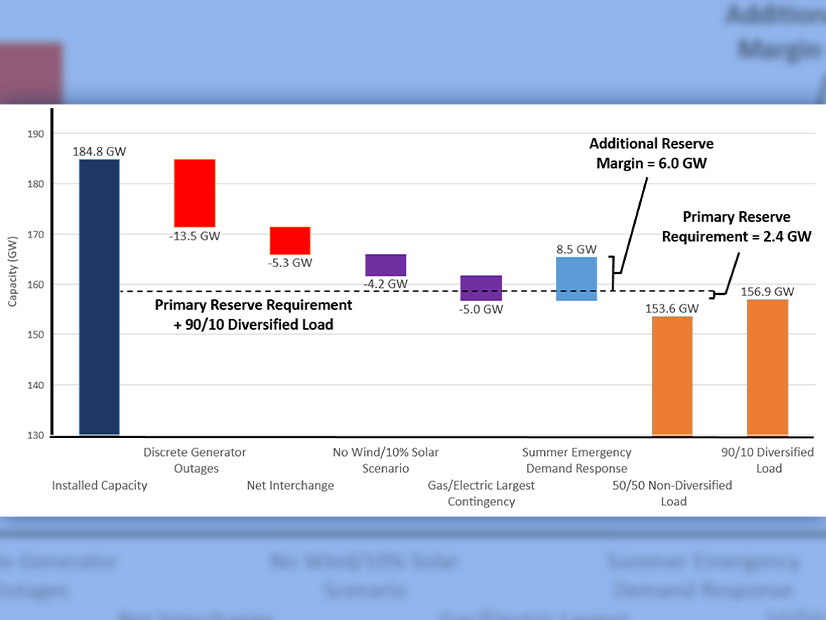PJM expects to have enough power supply to meet its summer electricity needs, according to a forecast released last week.
Todd Bickel, senior engineer in PJM’s transmission operations department, reviewed the results of the summer 2022 Operations Assessment Task Force (OATF) study at a meeting of the RTO’s Operating Committee, saying the peak load analysis did not identify any reliability issues.
According to the forecast, PJM has about 184,800 MW of installed generating capacity and is prepared to serve a forecasted summer peak demand of approximately 149,000 MW. Bickel said PJM has also performed reliability studies at higher loads of around 157,000 MW and still did not find any reliability issues.
“PJM works to ensure reliability, not just for ideal conditions, but we also plan for extreme events,” Bickel said.
Last year’s peak demand was about 149,000 MW, Bickel said, and PJM expects demand to be consistent with last summer. PJM’s all-time highest load was 165,563 MW in the summer of 2006.
Bickel highlighted PJM’s 2022 preliminary capacity expectation projections for the summer, saying the actual numbers may change slightly as the official summer months approach.
PJM anticipates discrete generator outages of 13,541 MW, Bickel said, where the value is determined by averaging the generation outages submitted during the top 10 peak days from the last three summers. The net interchange, or the RTO’s exports to its neighbors, is estimated to be 5,300 MW.
Bickel said the 2022 summer OATF case study is based on the 50/50 non-diversified peak load base case derived from the Load Analysis Subcommittee, which anticipates a load forecast of around 153,550 MW this summer. The preliminary RTO net interchange in the OATF estimates exports of 3,989 MW. Bickel said the net interchange case study number is different from the capacity projections because it accounts for 1,351 MW of pseudo ties in the OATF case model.
Stakeholders asked Bickel if the forecast’s net interchange number accounted for MISO’s announcement late last month that it could see a 1,200-MW capacity shortfall this summer. (See MISO Warns of Summer Emergencies, Load Shedding.)
Bickel said the numbers presented at the OC meeting don’t account for MISO’s latest report, but PJM is conducting several supplemental internal studies that do look at higher interchanges exporting from PJM.
“It is something that we definitely take into account as we approach the summer,” Bickel said. “One thing we look at in these additional studies is how far can we push the limits before we expect to see issues.”
For the 50/50 peak load study results, Bickel said no reliability issues were identified for the base case and N-1 analysis.
PJM also conducted sensitivity studies for external contingencies that could impact the RTO’s reliability and equipment within the footprint, and no reliability concerns were found.
Under N-1-1 relay trip conditions, Bickel said PJM identified no cascading outage concerns and all networked transmission overloads were controlled pre-contingency. The “max-cred” contingency analysis, which looks at maximum credibility scenarios, found no reliability concerns.
In the 90/10 load forecast study, which examined an elevated load of 156,928 MW, PJM observed no uncontrollable or unexpected issues, Bickel said.
PJM for the first time also ran a solar and wind generation sensitivity study for the summer and found no reliability concerns. The study assumed a loss of 4,200 MW of wind and a 10% solar scenario.
As part of preparations for the summer load, PJM said it has continued to work with transmission and generation owners to make sure all critical maintenance and system improvements are completed. The RTO has also continued conducting fuel inventories every two weeks to look for any issues of fuel supplies among the generation fleet, reporting that it has seen coal inventories begin to refill after running low during the winter.
“Predicting the demand for electricity helps PJM ensure that consumers have a reliable supply of power today and in the years ahead,” said Mike Bryson, PJM’s senior vice president of operations. “Load forecasting is something we do routinely, for both short- and long-term periods, to help ensure an adequate supply of power for reliable service at the most reasonable cost.”



